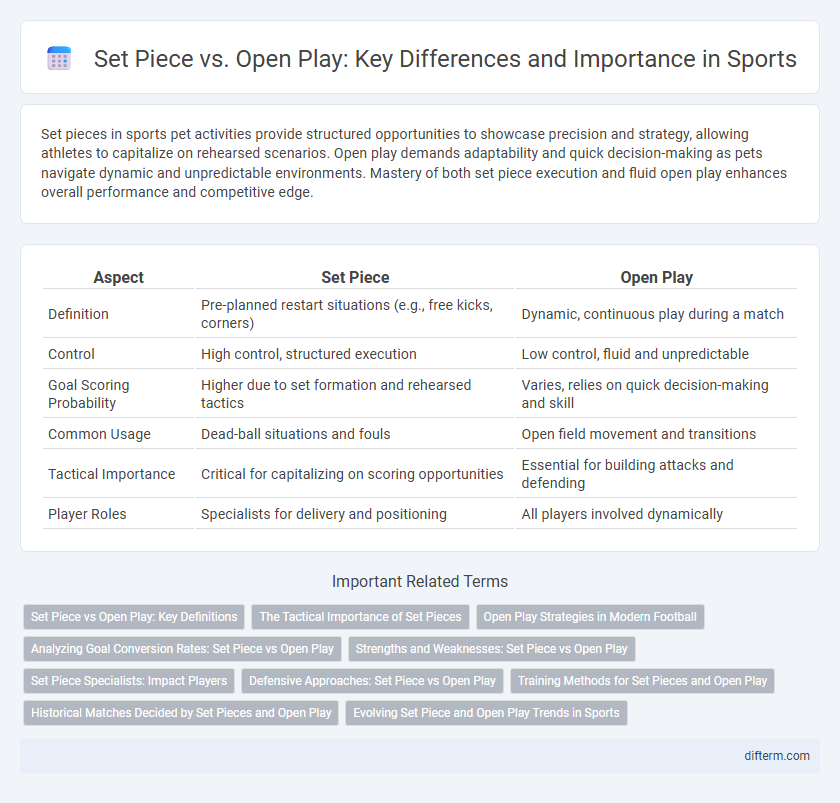Set pieces in sports pet activities provide structured opportunities to showcase precision and strategy, allowing athletes to capitalize on rehearsed scenarios. Open play demands adaptability and quick decision-making as pets navigate dynamic and unpredictable environments. Mastery of both set piece execution and fluid open play enhances overall performance and competitive edge.
Table of Comparison
| Aspect | Set Piece | Open Play |
|---|---|---|
| Definition | Pre-planned restart situations (e.g., free kicks, corners) | Dynamic, continuous play during a match |
| Control | High control, structured execution | Low control, fluid and unpredictable |
| Goal Scoring Probability | Higher due to set formation and rehearsed tactics | Varies, relies on quick decision-making and skill |
| Common Usage | Dead-ball situations and fouls | Open field movement and transitions |
| Tactical Importance | Critical for capitalizing on scoring opportunities | Essential for building attacks and defending |
| Player Roles | Specialists for delivery and positioning | All players involved dynamically |
Set Piece vs Open Play: Key Definitions
Set pieces refer to planned, static situations in sports such as free kicks, corners, and throw-ins, where teams execute rehearsed strategies to gain an advantage. In contrast, open play involves continuous, dynamic game phases where players respond spontaneously to evolving scenarios without structured pauses. Understanding the tactical and spatial differences between set pieces and open play is crucial for analyzing team performance and optimizing scoring opportunities.
The Tactical Importance of Set Pieces
Set pieces play a crucial tactical role in football, offering structured opportunities to capitalize on dead-ball situations such as corners, free kicks, and throw-ins. Teams invest heavily in rehearsed routines and positioning strategies to maximize scoring chances, often turning set pieces into decisive moments in tightly contested matches. Analysis shows that nearly 30% of goals in top leagues stem from set pieces, underlining their strategic importance compared to the fluid dynamics of open play.
Open Play Strategies in Modern Football
Open play strategies in modern football emphasize dynamic ball movement, spatial awareness, and rapid transitions to exploit opponents' weaknesses. Teams prioritize high pressing, quick counterattacks, and coordinated off-the-ball runs to create scoring opportunities beyond set-piece situations. Player versatility and tactical flexibility enhance the effectiveness of open play, driving sustained offensive pressure and possession dominance.
Analyzing Goal Conversion Rates: Set Piece vs Open Play
Goal conversion rates from set pieces typically outperform those from open play due to the structured nature and rehearsed strategies involved, with professional teams averaging around a 10-15% conversion from free kicks and corners compared to 7-10% from open play chances. Statistical models in football analytics reveal that set piece goals often result from higher expected goal (xG) values per attempt, emphasizing their strategic importance during matches. Coaches prioritize training on set pieces to optimize scoring efficiency, reflecting a clear trend where set piece execution materially impacts match outcomes.
Strengths and Weaknesses: Set Piece vs Open Play
Set pieces in sports offer structured opportunities to execute rehearsed strategies, enhancing scoring chances through precision and player positioning but can become predictable and vulnerable to well-organized defenses. Open play emphasizes fluidity and adaptability, allowing teams to exploit spaces and react to dynamic situations, though it risks losing possession due to less controlled environments and requires higher stamina and coordination. Balancing set piece efficiency with open play creativity optimizes overall performance by leveraging the disciplined threat of set pieces and the unpredictable pace of open play.
Set Piece Specialists: Impact Players
Set piece specialists possess exceptional skill in delivering precise free kicks, corners, and penalties, often turning dead-ball situations into decisive goals. Their ability to manipulate ball trajectory and exploit defensive weaknesses significantly increases scoring opportunities. Teams with outstanding set piece players typically show higher conversion rates from these situations, impacting overall match outcomes.
Defensive Approaches: Set Piece vs Open Play
Defensive approaches during set pieces emphasize organization, positioning, and tight marking to neutralize scoring opportunities from free kicks, corners, and throw-ins. In contrast, open play defense relies on dynamic spatial awareness, pressing, and coordinated team movement to intercept passes and disrupt attacking flow. Effective defenders adapt their tactics seamlessly between these scenarios to maintain solidity and minimize risks.
Training Methods for Set Pieces and Open Play
Effective training methods for set pieces emphasize repeated drills that simulate free kicks, corners, and throw-ins to enhance precision and coordinated team movements. Open play training prioritizes dynamic exercises such as small-sided games and positional play drills to improve decision-making, spatial awareness, and fluid ball transitions under pressure. Integrating technology like video analysis and GPS tracking refines both set piece routines and open play strategies by providing real-time performance feedback.
Historical Matches Decided by Set Pieces and Open Play
Historical matches often hinge on the effectiveness of set pieces versus open play, with famed encounters like the 2014 FIFA World Cup final showcasing decisive goals from both tactics. Set pieces such as corners and free-kicks have frequently altered game outcomes, exemplified by Diego Maradona's iconic free-kick in the 1986 quarter-final. Conversely, fluid open play movements led to legendary goals like Andres Iniesta's extra-time strike in the 2010 World Cup final, highlighting the strategic balance between structured set pieces and dynamic open play in football history.
Evolving Set Piece and Open Play Trends in Sports
Evolving set piece strategies increasingly leverage data analytics and player positioning to enhance scoring opportunities, while open play trends emphasize rapid transitions and spatial exploitation. Teams are integrating advanced video analysis and biomechanical insights to optimize free kicks, corners, and throw-ins. Simultaneously, dynamic formations and pressing tactics in open play foster fluidity and unpredictability, reshaping modern game dynamics.
set piece vs open play Infographic

 difterm.com
difterm.com